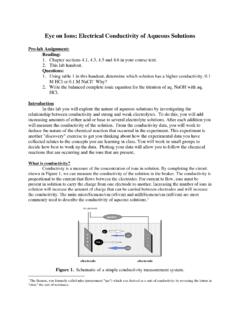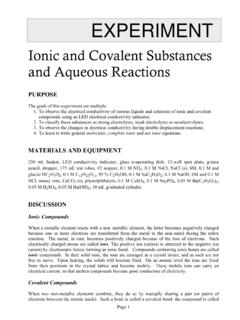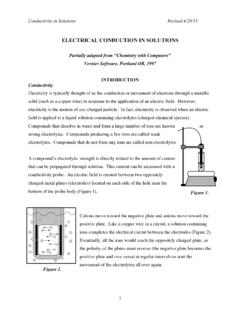Transcription of Ions in Solution - ChemConnections
1 Adapted from Peer-led Team Learning1 Early ideas of atoms and compounds, developed primarily through the reactions of solidsand gases, did not include the concept of charge. Atoms and molecules were seen asneutral particles. However, as the study of chemistry progressed to include solutions ,new models were needed because the old models could not explain electrical of the electrical conductivity of solutions , and other properties of solutions suchas freezing point depression and osmotic pressure, showed an interesting of compounds like sugar did not increase the electrical conductivity of water,yet they had lower freezing points than pure water. solutions of compounds such assodium chloride greatly affected the electrical conductivity of water, and they also causedthe freezing point of the Solution to be reduced twice as much as was observed in sugarwater new model that explained these observations was based on the concept that chargedparticles, which were called ions , formed in solutions .
2 If compounds like sodium chloridebroke apart into charged particles when in Solution , the ions could carry electrical such as sugar must not break into ions in Solution because they did notconduct electricity. These studies of the characteristics of solutions led to a morecomplete and accurate understanding of chemistry at the particulate and SoluteWhen a solid dissolves in a liquid to form a Solution , the solid is called the solute, and theliquid is called the solvent. This is the only case that we will consider in this , these few terms are insufficient to describe solutions in general. They will beexpanded upon in the workshop of potassium chloride crystals Begin at the go on till you come to the end: thenstop."Lewis CarrollIons in SolutionAdapted from Peer-Led Team Learning2 SolubilitySolubility is a measure of how much solute can dissolve in a given amount of solvent.
3 Awide variety of units of concentration can be used for this describing how much of a given solute dissolves in water, the most common,"universal" solvent, the semi-quantitative terms: soluble, slightly soluble, and insoluble,can be used. These terms are applied quite loosely, and there tends to be substantialvariation in the ranges of these categories and other descriptive terms. A more detailedtreatment will be provided in a later workshop, solutions . A table and a set of a fewgeneralized rules follow that summarize the solubility characteristics of a number Solubility Rules for Ionic Salts in nitrate (NO3 ) salts are sodium, potassium, and ammonium (Na+, K+, NH4+) salts are chloride (Cl ) salts are soluble. Notable exceptions are AgCl, PbCl2, sulfate (SO42 ) salts are soluble. Combinations with sulfate ion which forminsoluble compounds are: SrSO4, BaSO4, Hg2SO4, Ag2SO4, and hydroxide (OH ) salts are only slightly soluble.
4 The important solublehydroxides are NaOH, KOH, and Ca(OH) sulfide, carbonate, and phosphate (S2 , CO32 , PO43 ) salts are onlyslightly from Peer-Led team Learning3 Electrolytes and NonelectrolytesAn electrolyte is a compound whose aqueous Solution contains ions . When NaCl dissolvesin water, the compound dissociates into Na+ and Cl ions . A good test to determinewhether or not a compound is an electrolyte is to measure the ability of its water solutionto conduct an electrical current. Consider a battery which has both a positive and anegative pole. If the poles are immersed in a Solution via conductive metal electrodes, suchas copper wires, the positively charged sodium ions in the Solution will move toward thenegative pole and the negatively charged chloride ions will move toward the positive a Solution has a high contrast, if a neutral molecule such as sugar is in Solution , it will not move towardeither pole and the Solution will be a and Weak ElectrolytesElectrolytes can be further classified as strong or weak electrolytes.
5 Strong electrolytes arecompounds like NaCl, which are nearly 100% dissociated in Solution . This means thatnearly every sodium chloride formula unit exists as sodium ions surrounded by watermolecules and chloride ions surrounded by water molecules. We can represent this by thefollowing equation:NaCl(s) Na+(aq) + Cl (aq)The Proton in ChemistryAcids and bases form a special and very important class of electrolytes. Some acids, suchas hydrochloric acid, HCl, almost completely dissociate in aqueous Solution . They arestrong electrolytes. These acids are similar to sodium chloride in that they exist as ionswhen in Solution . Other acids such as acetic acid, CH3 COOH, dissociate only slightlywhen dissolved in water. These are classified as weak electrolytes. For example, at acertain concentration and temperature, only four of every one hundred acetic acidmolecules will ionize in Solution .
6 We represent the ionization of weak electrolytes insolution with double arrows as shown below:CH3 COOH(aq) CH3 COO (aq) + H+(aq)In the case of a strong acid such as HCl, a single arrow is used in the reaction indicates that essentially all the HCl molecules (aq) H+(aq) + Cl (aq)Acids can be defined as substances that release hydrogen ions , H+(aq), in Solution . Theconcentration of H+(aq) in Solution is an important factor in a great number of chemicalprocesses, including many of biological interest. Common acids that you may be familiarAdapted from Peer-Led Team Learning4with include hydrochloric acid (sometimes called muriatic acid), which is used to controlthe acidity of swimming pools, sulfuric acid, found in automobile batteries, andphosphoric acid, which is widely used in colas for we will consider the chemical opposite of acids, which are compounds known asbases.
7 A base is a compound that produces hydroxide ions , OH (aq), in Solution . As withacids, bases can be classified as either weak or strong. An example of a strong base issodium hydroxide:NaOH(s) Na+(aq) + OH (aq)Ammonia is a common weak base:NH3(aq) + H2O(l) NH4+(aq) + OH (aq)When acids and bases react with each other, they form an ionic salt and water in what iscalled a neutralization reaction. Examples include:NaOH(aq) + HCl(aq) Na+(aq) + Cl (aq) + H2O(l)Ba(OH)2(s) + H2SO4(aq) BaSO4(s) + 2 H2O(l)The salt may be soluble in water, as is sodium chloride, or it may precipitate out as asolid, as does barium : Chemistry's Most Often Used Concentration UnitChemists for ease of application use a specialized mole-based system of concentrationunits to express the amount of solute in a Solution . This system allows chemists to easilyextend stoichiometric calculations to reactions that occur in is defined as the number of moles of solute per liter of Solution and is given thesymbol M:M moles of solutevolume of Solution in L When chemists prepare solutions , they usually refer to the molarity of the compounddissolved in the Solution , whether or not it exists as ions .
8 For example, if sufficient wateris added to dissolve mole of NaCl and bring the total Solution volume to L, thenthe Solution is called a M NaCl Solution . We know that there are no NaCl particlesin the Solution , but rather Na+(aq) and Cl (aq) from Peer-Led team Learning5 Chemical Analysis by TitrationReactions in Solution are useful for determining the amount of a particular chemicalspecies present in a given aqueous sample. For example, swimming pool water is oftenanalyzed for its acid content. One way to determine the amount of acid in a Solution is totitrate the Solution with a base of known concentration. To analyze a Solution thatcontains the acid HCl, for example, you can add a known concentration of the base NaOHin small amounts until all of the acid is neutralized. By measuring the volume of NaOHsolution needed to neutralize the HCl, the moles of NaOH added can be determined.
9 Sincethe reaction of HCl and NaOH occurs in a 1:1 ratio, at the equivalence point of thetitration, the moles of NaOH added must be equal to the moles of HCl in Solution . Thereaction equation isHCl(aq) + NaOH(aq) Na+(aq) + Cl (aq) + H2O(l)In every titration, we need a way to determine the point at which the reaction iscomplete. In the case of our example titration of NaOH into HCl, the net ionic equation isH+(aq) + OH (aq) H2O(l)The equivalence point is reached when all of the H+(aq) ions in the HCl Solution havereacted. The consumption of H+(aq) can be detected by employing a chemical dye knownas an indicator. Indicators change color when the hydrogen ion concentration of a solutionchanges substantially. The color change signals the endpoint of the titration. A pH metercan also be used to measure the H+(aq) in Solution and signal the we noted earlier, we can apply stoichiometric calculations to reactions that occur insolution.
10 The macroscopic particulate conversion is made with the molarityconcentration unit. Molarity allows us to convert from moles to liters and vice to consider the titration of sodium hydroxide Solution into hydrochloric acid:Assume that we want to know the concentration of a mL ( L) sample of the balanced chemical equation we know that 1 mole of HCl reacts with 1 mole ofNaOH. If the titration required mL ( L) of M NaOH Solution , theconcentration of the HCl Solution is calculated as L mol NaOHL 1 mol HCl1 mol NaOH = mol mol L = mol HClL = M HClAdapted from Peer-Led Team Learning6 Name(s) _____Workshop: ions in Solution I1) For each of the following compounds, (a) write the formula and (b) classify it as eithera strong or a weak electrolyte or a , Weak or Non-ElectrolytePotassium hydroxideAcetic acidSodium chlorideOctaneSucroseEthanol2) For each of the following, a description of a Solution is provided.











